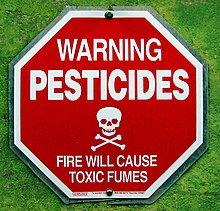| Pesticide toxicity | |
|---|---|
 | |
| A sign warning about potential pesticide exposure | |
| Specialty | Emergency medicine, toxicology |
A pesticide poisoning occurs when pesticides, chemicals intended to control a pest, affect non-target organisms such as humans, wildlife, plants, or bees. There are three types of pesticide poisoning. The first of the three is a single and short-term very high level of exposure which can be experienced by individuals who die by suicide, as well as pesticide formulators. The second type of poisoning is long-term high-level exposure, which can occur in pesticide formulators and manufacturers. The third type of poisoning is a long-term low-level exposure, which individuals are exposed to from sources such as pesticide residues in food as well as contact with pesticide residues in the air, water, soil, sediment, food materials, plants and animals.[1][2][3][4]
In developing countries, such as Sri Lanka, pesticide poisonings from short-term very high level of exposure (acute poisoning) is the most worrisome type of poisoning. However, in developed countries, such as Canada, it is the complete opposite: acute pesticide poisoning is controlled, thus making the main issue long-term low-level exposure of pesticides.[5]
- ^ Gupta RC (28 April 2011). Toxicology of Organophosphate & Carbamate Compounds. Academic Press. pp. 352–353. ISBN 978-0-08-054310-9.
- ^ Hamilton D, Crossley S (14 May 2004). Pesticide Residues in Food and Drinking Water: Human Exposure and Risks. John Wiley & Sons. p. 280. ISBN 978-0-470-09160-9.
- ^ Owen LA, Pickering KT (1 March 2006). An Introduction to Global Environmental Issues. Routledge. p. 197. ISBN 978-1-134-76919-3.
- ^ Yassi A (2001). Basic Environmental Health. Oxford University Press. p. 277. ISBN 978-0-19-513558-9.
- ^ Cite error: The named reference
Jeyaratnam_1990was invoked but never defined (see the help page).